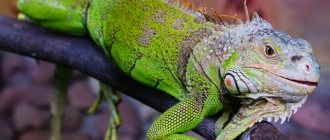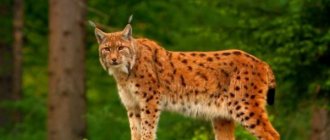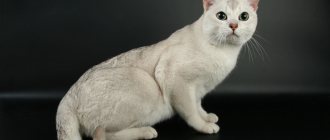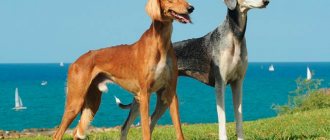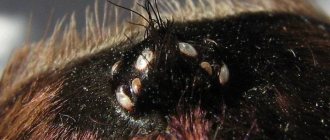Lynx structure
The study of the anatomical structure of animals, taking into account their characteristic features belonging to a certain breed and species, sexual characteristics and age characteristics is extremely necessary in the development of biological sciences.
Zoologists, ethologists, trackers, hunters and many people interested in the life of the lynx wild cat study its habits, behavioral characteristics and traces of vital activity. The anatomy of the lynx allows them to understand and master knowledge not only of the external structure of the animal, but also to comprehend the internal structure of the body.
Among other things, the anatomy of a lynx is capable of revealing the potential capabilities of a predator, as well as anticipating and managing the paths of evolutionary improvement of its body.
Care and maintenance of lynx at home
It should be noted that people who keep ordinary wild lynxes in captivity note their unpretentiousness and good adaptability. If the lynx did not have such a strong predatory element, it would be a very convenient pet. But the common lynx can be kept exclusively in an enclosure in compliance with all the rules for handling a predator. But the domestic lynx was bred to live in the house like a cat. And yet, although a cage is not necessary for it (no, not like that - a cage won’t do at all, but you can keep your pet in a spacious enclosure), in any case, this big cat needs some kind of corner, its own territory. It would be great if there was some kind of tree there, or, in extreme cases, shelves that you can climb and jump over. This is important, because by nature the lynx is given developed muscles and high motor activity, which must find a way out. A claw sharpener will also not be superfluous, otherwise the furniture in the house would cry. Well, and the tray, of course - you will have to be patient and accustom the kitten to it.
The domestic lynx is subject to the same misfortune as ordinary cats - it swallows fur when licking and can choke on it. Therefore, it is strongly recommended to periodically comb your cat and generally care for its fur. Medicines for cleansing the intestines, in which hair may accumulate, will also not be superfluous.
Subject to these maintenance rules, a domestic lynx can be a cozy and interesting pet, intelligent and trainable. However, it is still not recommended to have this animal in families with small children. After all, predatory instincts, even if somewhere very deep, still sleep in this graceful and calm-looking animal, and who knows what could happen if they are awakened.
What to feed a lynx?
You need to feed the lynx correctly. A large individual eats four hundred grams of raw meat at a time. And you need to feed your spotted pet twice a day. In addition to meat, the lynx happily eats dry food and canned fish. But you need to gradually accustom your predator to canned food. In addition, it is imperative to add various vitamins, as well as minerals and calcium to your food. The diet of this pet must be very balanced and nutritious, and the presence of rough components (bones, veins, etc.) that provide regular load to the jaw muscles is required.
How does a lynx get along with children?
Lynx gets along very well with children. And besides, she can become a real nanny for the baby. The most interesting thing is that children can pull their pet's whiskers and tail. In response, the lynx will steadfastly endure all the “bullying of the little master.” But he does not forgive adults for insults. That's why you can't beat him. Since the lynx will take revenge for these blows for a very long time and cruelly.
A young male needs to be castrated, otherwise there will be a very specific smell in the apartment. And finding a match for your pet will be almost impossible. Do you know what happens to your cat’s character after castration?
In general, keeping a predator at home is very difficult. First of all, it's a big creature. And secondly, very often this pet exhibits hunting instincts. And then problems will arise for all living beings in the area.
general characteristics
Lynx is a mammal of the vertebrate class, belongs to the cat family and is very similar to them in morphological and anatomical characteristics. Its main distinguishing features are a short thick tail, large triangular ears with tufts of long, coarse hair, and long fur on the sides of its round muzzle.
The predator inhabits a vast territory of the northern hemisphere, so its appearance and size vary greatly depending on the species and habitat:
- Common or Eurasian. The largest species, body length reaches 100-120 cm, height at the withers 70-80 cm. Males are slightly larger than females, weighing 23-25 kg, sometimes individuals weighing up to 30 kg are found. The weight of the female fluctuates around 20 kg. The length of the predator's tail is 23-24 cm. The fur of this species of lynx is very thick; in winter, gray and light red shades with rare spotting predominate. In summer the color becomes brighter.
The East Siberian and Caucasian lynx are subspecies of the common lynx. The Caucasian is slightly inferior in size to its wild relatives, its body length is 80-100 cm, height up to 50 cm. The weight of the predator is from 10 to 15 kg. The lynx fur of this subspecies is rarer and smaller, the color is dominated by bright red shades with well-defined brown spots.
- Canadian. An order of magnitude smaller than ordinary, its body length is slightly more than 70-80 cm, the average weight of an adult is fixed at 9 kg. The animal's tail is short, no more than 17 cm in length. The lynx's fur is colored in gray tones, with small white splashes; sometimes there are ash-blue shades. The spots are few in number, not clearly expressed, and sometimes merge with the overall color. The fur on the belly is thick, lighter, sometimes gray-white. The fur on the back of the ears, at the end of the tail and along the edge of the whiskers is black.
- Redhead. The smallest representative among all species. Due to the lack of need to move through deep snow cover, it has shorter, thinner limbs and less massive paws. The tail of a lynx of this species has a distinctive feature from its other representatives - its color at the end is not pure black, but with predominant white spots. The body length of the animal does not exceed 80 cm, the height at the withers, depending on gender, is from 30 to 50 cm, the weight of an adult is 10 kg. The lynx's fur is not thick, relatively short, light brown in color, and gray on the belly. Dark, pronounced spots are abundantly distributed on the inside of the limbs and on the sides of the predator.
- The Iberian or Iberian lynx, which inhabits the mountainous regions of Spain and Portugal, is the smallest species, numbering just over 300 individuals. The size of the animal is slightly smaller than the Eurasian wild cat, its weight ranges from 12-17 kg. A distinctive feature from other species is the fur of the lynx. Its color is dominated by gray-brown shades and there are often bright dark spots throughout the surface, which makes it extremely similar to the leopard color.
The skeleton of the animal is typical of all vertebrates. The skull is wide, short, the area between the eye sockets is high, the nasal bones are large. The lynx is endowed with very powerful short jaws, the bite of which is fatal. An adult has 30 teeth - the fangs are long and sharp, used to hold and tear food, and the carnassial teeth (molars) are used to cut tendons and chew bones. The grin of a predatory jaw as a threat or defense looks terrifying.
Along with blade-sharp teeth, the lynx's claws are also a perfect weapon of defense against enemies and a tool for attacking prey.
How does a lynx protect itself from enemies?
The main enemy of the lynx is man. People hunt this animal for its beautiful fur and because the predator destroys a lot of livestock. How does a lynx protect itself from human enemies? When meeting, it tries to hide in a tree; the cat rarely attacks a person first. If the hunter does shoot, the wounded lynx becomes uncontrollable! She jumps on his chest and digs her fangs and claws deep into his body.
In winter, packs of wolves and wolverines are serious enemies of the lynx. It is still unknown why wolves hate lynxes so much. Either the meat is tasty, or there is competition from predators. If the lynx is mature and experienced, then it escapes from wolves in a tree, but sometimes a young cat cannot withstand a wolf siege under a tree and tries to escape. As a result, certain death awaits her; the wolves cut the lynx off from the trees and kill the fugitive who fell on her back. She will defend herself to the last with all four paws, but she will not be able to resist the pack.
Vision
Nature has endowed the wild cat with very sharp vision, the ability to clearly focus on a moving object during the chase and maneuvering. The lynx's eyes are designed in such a way that they are able to capture the slightest rays of light reflected from objects. This allows the animal to hunt during the twilight hours - at dawn and before nightfall. But at the same time they do not perceive ultraviolet and infrared radiation ranges.
The shape of a lynx's eye is round, elliptical, with sharp outer corners. The color of the iris is mostly sand-colored, but some representatives of the caracal species have blue eyes. The animal's pupils are slightly oval, have a vertical position, and at night they dilate and become round, thereby regulating the supply of light. In complete darkness, a wild cat cannot see, but has excellent orientation thanks to the vibrissae - highly sensitive long hairs on the face and ears that detect the slightest sound vibrations.
What does the common lynx eat?
The main food of the lynx are hares, roe deer, rodents, and various birds.
For unknown reasons, he has a terrible dislike for foxes. She does not eat them, but does not miss the opportunity to kill them.
During the snowy season, the animal can attack larger animals. Thanks to its long legs and furry paw pads, the cat can move through the snow without difficulty.
The common lynx goes out in search of prey at nightfall. There is an opinion that it attacks prey from a tree, but this is not so. The predator prefers to wait patiently or sneak up with careful steps and attack sharply.
The animal tries to avoid people. It hears their approach several kilometers away and tries not to catch their eye. When hard times come and the lynx does not have enough food in the forest, it may enter nearby settlements to profit from a cat or dog. This predator can overcome an adult shepherd. But cases when they appear among people are very rare; they can mainly be found in dense coniferous forests.
Predator Paws
The lynx is endowed with long limbs with wide, powerful paws. The prints of the front feet are round in shape, the hind ones are elongated and more oval. The diameter of the front paw prints of an adult animal in summer is approximately 7.7x7.9 cm. In winter, the animal’s feet become heavily overgrown with long hair, which covers the entire surface of the sole and increases its print on the snow at least twice - up to 16-17 cm in diameter , and sometimes up to 23 cm. The size of the footprint of the hind legs in the warm season is 7x9 cm.
The predator has four toes on its hind limbs and five on its front limbs. The fifth, thumb, is very shortened, not opposed to the others and is placed higher, so it does not leave an imprint when walking. Lynxes are digitally walking animals; their voluminous toe pads and metatarsal pads evenly distribute the mass of the predator over the entire foot.
Prey and diet
Most often, the lynx hunts hares; as food it is interested in wood grouse, black grouse, martens, and hazel grouse. Less common are attacks on medium-sized ungulates, among which are:
- red deer;
- roe deer;
- musk deer;
- young boars.
The search for food can take days, during which the animal travels 30 km or more. There are known cases when, in years of famine, he approached populated areas and hunted small livestock, dogs, and cats. If the prey is not completely eaten, the animal buries it in the ground in the summer and in the snow in the winter.
There is information about an unusual fact involving unmotivated aggression towards foxes. At the first meeting, the predator strives to tear the victim apart, but never eats it.
Lynx claws
The animal's paws are equipped with long, sickle-shaped claws, which are keratinized appendages of the finger bones. Between the fingers of the predator there are leather membranes located from the base of the finger to the upper phalanx. The lynx's claws are very sharp, can reach 5 cm or more in length, and are shorter on the hind legs than on the front ones. Their upper surface consists of keratin, inside there is living tissue with blood vessels and nerve endings.
The lynx's claws, like those of most cats, are retractable. They are driven by muscle tendons, which the predator tightens or weakens depending on the situation. An animal that stalks prey stealthily hides its claws in order to move silently, and when walking, to protect them from mechanical damage. A wild cat uses its hind legs mainly for support; the function of the front legs is, in addition to movement and protection, also for attack. Therefore, the lynx's claws on the hind limbs are renewed less often; they are short, harder and rougher.
Population and species status
Today, the presence of several dozen individuals is observed on the territory of the Balkan Peninsula, and in Germany, Switzerland and France, mass extermination has required the repopulation of the common lynx.
The largest lynx population is located in the Carpathians and Poland. Quite a large number of individuals are found in Belarus, Scandinavia, Central Asia, Latvia and Estonia. On the territory of our country, you can most often find the common lynx in Siberia.
For commercial purposes, the common lynx is not in great demand - only the fur of this predatory animal is used. It is distinguished by its thickness, silkiness and sufficient height, as well as the presence of a soft underfur. The average guard hair length in an adult is approximately 60-70 mm. But along with many other predators, lynxes play a very important role in the natural biocenosis.
Despite the fact that the taste characteristics of lynx meat are very high - it is similar to veal, has a delicate texture, according to long-established traditions, in some countries it is not customary to use it for food purposes.
This is interesting! In Ancient Rus', rich nobles were treated to lynx meat, and dishes made from such meat were served on the table of boyars and princes as an expensive delicacy.
Even in the last century, on the territory of European countries, the total number of common lynx dropped quite sharply and greatly to only a few hundred individuals. The destruction of forest areas, poaching and a reduction in the total food supply had a negative impact on the total number of predatory animals. Today, various measures are being taken to not only preserve, but also increase the number of this incredibly beautiful predator.
Leather
The skin of a wild cat consists of epidermis and dermis and has the unique ability to be mobile. This property is invaluable during predator fights or in the fight against prey. The skin is supplied with nerve fibers, blood vessels and is densely covered with hair. A hair follicle can accommodate up to 5-6 axial hairs, which, in turn, are surrounded by downy hairs. The muscles located in each follicle raise and lower the fur during fear or anxiety, as well as in cold weather, helping to reduce heat loss.
The skin of a lynx not only protects it from the cold, but also protects it from sunburn, as well as from all kinds of damage.
The predator's fur is very thick and warm, unrivaled among felines. At the same time, it is heterogeneous - shorter on the back, long on the belly, silky, often white. Lynx skin is extremely valued and in demand along with the fur of fur-bearing animals.
Having examined the structure of the predator and some structural features of its body, it is obvious that the anatomy of the lynx and the physiology of this mammal is characterized by the presence of more advanced functional systems than other representatives of the vertebrate class.
Reproduction and offspring
The common lynx is a predator leading a solitary lifestyle. The lynx rut begins in March. During this period, predators emit very characteristic loud screams, and also purr or meow loudly. At the rutting stage, each female is accompanied by several males, fiercely fighting with each other. Educated married couples perform a kind of greeting ritual, and affection is expressed by licking each other's fur.
This is interesting! The female's gestation period varies between 64-70 days. One litter usually consists of a pair of kittens, but sometimes their number can reach five. The born lynx cubs are blind and deaf, so the female initially hides them in a den, which is located under the roots of fallen trees, in deep holes or earthen caves. Also, some females sometimes make a den in low-lying hollows or in large rocky crevices.
The average weight of a newborn kitten, as a rule, does not exceed 250-300 grams. The baby lynx's eyes open only on the twelfth day. Until about a month, the female feeds her cubs exclusively with milk, after which gradual feeding of solid protein foods begins. Raising kittens is carried out by both parents, who not only protect their offspring, but also teach them how to get food for themselves and hide from enemies. Sexual maturity in females occurs closer to two years, and in males several months later.
Appearance
The weight of a male lynx reaches 25 kg and length is 130 cm (that’s almost as big as me). Female lynxes are slightly smaller. The name lynx comes from the word red. The lynx's fur is very valuable, thick and fluffy, colored in different shades of red with gray spots throughout the body. The fur on the belly is pure white and longer than on the back. Its tail is chopped off. The lynx has long tassels on its ears, and the fluffy fur on the sides of its muzzle resembles whiskers. The lynx has powerful paws, which are overgrown with thick hair in the winter, which allows the animal to walk in the snow in winter without falling through. The lynx has very sharp eyesight and is a symbol vigilance.
Taiga Sphinx
Lynx is a mysterious inhabitant of the taiga forest zone. It feeds mainly on hares. careful. But sometimes, for some reason, it fearlessly appears on forest cordons - it will climb onto the roof of a barn, and can even enter the open entryway of a house.
I have only seen this animal in the wild once. In Alaska, we drove through the Kenai, an unusually picturesque peninsula. We looked just above the forest at a blue series of mountains. Suddenly the driver smoothly slowed down and said in a solemn whisper: “Lynx...” (trot). Right next to the road, about twenty meters from the car, a lean, somewhat clumsy brown-gray animal stood and calmly looked at us. His silhouette stood out clearly in the snow. Lynx... Such a close encounter with a hunter near the road would threaten the lynx with the loss of a beautiful fur coat. But now she seemed to understand: there was no danger. She looked at us without the slightest concern and did not rush into the forest, which was darkening behind her, but slowly crossed the road at a leisurely pace. The lynx's long legs resembled stilts, but the movements were leisurely and smooth. The animal did not even look back, without haste or panic, it disappeared into the snow-covered small forest.
And many times I saw this beast up close, in captivity. But even here the lynx was never fussy. She even approached tasty food slowly, taking it in her teeth as if she was doing you a favor. Often I saw the animal sitting calmly, with its gaze directed somewhere into the distance. Expressive eyes bordered with light fur, pricked ears with black tassels of hair at the ends and whiskers make this animal unusually beautiful. I even thought once with a smile: lynxes gave people the idea to wear sideburns.
One of the lynxes I knew was so docile that she allowed me to enter her spacious cage. I entered on tiptoe, but my fears were in vain. The cat acted as if I was not there. For some reason she was interested in the strap on my photographic bag. She smelled it and tasted it. And I sat without breathing - admiring the iridescence of smoky-red fur with rare spots, the white fur of the underbelly, sideburns, tufts on the ears and snowshoe paws.
The lynx's legs are powerful. It seems that when “tailoring” this beast, nature used most of the material for the legs. No claws are visible on the paws. The lynx, like all cats, wears mittens, and you won’t see claw prints in the snow with a round footprint. But hares are well aware of claws - the lynx's main prey.
The size of the lynx is a medium-sized dog. But this is a typical cat - nocturnal, patient in ambush, swift in attack. The lynx has excellent hearing and cat-like habits - independent, cautious. Just like cats, he has a weakness for valerian (“He digs up and eats the roots and then, stupefied, forgetting about everything in the world, lies around”). Lynx cats fight at weddings before spring, meow loudly and yell, like our March cats.
The lynx's habitats on Earth are large: northern forests in Europe, taiga in Asia, northern America, including Alaska. But the lynx is not numerous everywhere, and as people penetrate into the north, the animals become fewer and fewer, for there are almost no cases when, having met a lynx, a person does not use a gun. A lynx can also attack a person, but this happens extremely rarely - wounded or persecuted.
In the south, the forest cat has a relative - the desert lynx, the caracal. Looking at a caracal, you immediately pay attention to the ears. They are large and also have tassels - to survive in the desert, you need to hear especially well. And in agility, the lean, seemingly thin caracal is perhaps superior to the lynx - “having jumped up, he catches birds in flight.”
And our northern neighbor prefers neglected, impassable forests, with special preference given to rocky places. The mother lynx's lair is rarely found - it is so skillfully hidden. It is still known: the lynx has from one to four kittens (usually two). Like wolves, the male helps the mother raise her cubs. Having matured, the kittens begin to hunt together with their parents, learning the science of life in the forest. (By October, lynx calves born in May can no longer be distinguished from adults.)
Lynxes are tireless walkers, swim well, climb trees excellently, and are patient in ambushes. “They can sit motionless on a branch for days. They have everything below at their fingertips, and it’s almost impossible to notice them.” Lynxes prefer to stick to their homes, but when game is scarce, they have to scour—walk, look for food. In family groups, their tactics are wolfish: they follow the trail and hunt together - in a corral. Just like wolves, in their excitement they kill more than they can eat, and sometimes, when full, they abandon their prey without even “taking a bite.”
In the southern taiga, where the choice of game for these skilled hunters is very large (musk deer, roe deer, young elk, deer, black grouse, wood grouse, hazel grouse and, of course, hares), lynxes do not suffer. But in the northern zones, where life is poor, the main dish on the lynx’s table is hare. The forest cat is exceptionally adapted to hunting these also short-tailed animals - it quickly pursues at a run and makes large jumps, deftly repeating the death throws of the prey. One bunny per day is the norm for a lynx.
Lynxes ferociously chase foxes (competitor!), but when they kill them, they won’t eat them and abandon them. Wolves treat lynxes the same way they treat foxes—they pursue them very persistently, but for food. The lynx usually seeks refuge in a tree. And if it is high, everything is in order, the cat will look down on the wolves with contempt. But if the tree is low, the wolves will come out of their skin - they will jump, pull branches with their teeth to force the cat to jump to the ground. I jumped and that was the end. Wolves are very fond of lynx meat. And not by chance.
In Alaska, when I began to tell an Indian hunter about meeting a lynx on the Kenai road, my interlocutor nodded his head: “Yes, yes, lucky...” Immediately the Indian went into the canopy and returned with a piece of frozen whitish meat. While we talked to our heart's content about this and that, the meat was fried on a huge cast-iron "Alaskan stove." Continuing the conversation, we sat down at the table. I praised the treat, realizing that it was game. But which one? It turned out... lynx. Cat hunting is restricted in Alaska. Aboriginal Indians are allowed to kill one lynx per year in a designated area. But even the most dexterous hunters in the world do not always succeed.
Preparing to sit down to write these notes, I read: lynx meat was once highly valued by Europeans. In the Middle Ages, lynx was served at castle dinner parties. Successful hunters sent expensive game to noble nobles. At the Congress of Vienna (1814, the celebration of the victory over Napoleon), roast lynx was served during feasts.
There were many reasons to pursue the animal: gastronomic, hunting for fur, and also revenge - lynxes happened to crush lambs in Alpine sheep flocks. The last lynx in German forests was shot in 1838.
Nowadays, lynx is usually an accidental catch of a commercial hunter. The animal is as rare as the leopard, a tropical cat, and the wolverine in the North. “The minimum for her life: wild, virgin forest, snow and bunnies,” a Siberian hunter told me, who in thirty years had only shot at a lynx twice. — The animal is smart, calm and reasonable. He never loses his presence of mind, always looking for a way out of critical situations. And very beautiful! Look, there’s a skin hanging there—I didn’t dare sell it. And, I admit, I regretted that I shot. Beautiful mysterious beast!
The habits of the lynx have not been studied well enough. “A nocturnal animal, it sleeps during the day...” But it was during the day that you only saw lynxes, as you would see at night? “The lynx is picky about food—it won’t return to its scraps.” But here’s another piece of evidence: “He’s coming back! He gnaws on frozen and rotten meat.” “Extremely careful...” That’s right. But, on the other hand, many cases have been described when lynxes carelessly went out to the roads and entered villages. In the Yaroslavl region, a forester told me how he was amazed to once see a lynx on the roof of a barn. Brem constantly emphasizes: intolerant of cats, breaks it up immediately. But I took a picture at a zoo in Petushki, Vladimir region, about twenty years ago: all the local cats were visiting a lynx sitting in a cage, and four murkas were lying on the lynx’s soft side, like on a mattress.
“A mysterious beast,” said the Yukon Indian. Everyone who has observed the wild cat for at least some time agrees with this. But the contradictions mentioned above can be sorted out. Yes, they prefer fresh food; when there is a lot of it, they throw away the uneaten food. But, as they say, it’s not always Maslenitsa for the cat. The lynx also has hungry days and returns to leftovers. Extreme caution and seemingly protruding ears - climb onto the roof of the barn... But there is no particular contradiction here. The lynx is a pronounced savage, not very afraid of humans. Innate caution is combined in her with a special curiosity characteristic of many animals. And finally, cats... I don’t know what to say here. The photo is in front of me. Perhaps, out of slave boredom, the forest cat showed hospitality to its obvious relatives. Or perhaps a special character. Animals, like people, have characters that differ markedly.
The beauty, expressive appearance of the lynx... For many years, the lynx has been a mandatory character in films about animals. In one film, I remember, they filmed an adult animal. The director (I think it was Babayan) called this lynx a genius: “Almost like a person, it understands what you want from it.” But one day the “brilliant” lynx, forgetting about filming, walked and walked... and disappeared into the forest. They were waiting for him to return. No, she didn't come back. Fate? Most likely, the “actress” died. Not adapted to life in the wild from childhood, predators die. But filming continued. For these cases, filmmakers keep an animal double. But the understudy, although he was the brother of the departed lynx, had no acting talent. “What we used to do in a day, we now do for two weeks,” the director lamented. Characters! They vary among all animals, but among lynxes they vary, perhaps a little more. Hence the sphinx, a mysterious beast.
Lifestyle and habitat
Since these animals are now few in number, they lead a predominantly secretive lifestyle. Accordingly, the chance of seeing it in the wild is quite small. Even with a strong desire, it is not so easy to find a cat, since it prefers such supports that are not easy to get close to. For example, it could be an old cluttered windfall or a dark taiga forest with a dense undergrowth of coniferous trees.
However, there is a chance to meet a lynx in a young forest. The predator does not attack humans, preferring to avoid encounters. The animal is able to recognize the presence of a person at a distance of several hundred meters, after which it begins to silently leave, occasionally stopping to listen.
If the lynx is very hungry, it may even go into the city, where it will attack a dog or cat. Even an adult shepherd cannot compare in strength to a predator. However, few cases of lynx appearing in cities have been observed, as they prefer dark coniferous forests.
Lynx is a wild animal , therefore it prefers a nocturnal and twilight lifestyle. It starts hunting after dark. It feeds mainly on hares. If possible, it may attack an ungulate animal: roe deer, wapiti or young wild boar. Easily catches a squirrel or marten. The meat of hazel grouse, black grouse and wood grouse is considered a favorite delicacy. In the winter season, it tracks holes.
An interesting fact is that the lynx does not like foxes, so it hunts them as soon as the chance arises. However, he doesn’t eat it. The hunting qualities of these cats are even better than those of leopards and wolves. With the onset of evening, everything around becomes silent and at this time the lynx goes out to hunt, listening to the smallest sounds.
Having determined that there is prey nearby, the cat slowly makes its way to it, without making unnecessary noise. A convenient distance for an attack is considered to be 10-20 m. 2-3 jumps are enough to grab onto the food. If the prey, for example, a hare, senses something is wrong and starts to run away, the lynx may chase it for a short time, 50-100 m, after which it stops.
Sneaking is not the only hunting style. He also prefers a wait-and-see position, in ambush. Favorite places are hare trails or ungulate watering holes. The lynx does not like to jump from trees, although it can rest on branches with all 4 paws hanging down.
Prey in the form of 1 hare will be enough for a cat for 2 days. If the trophy is a roe deer, this provides the animal with food for the week ahead. It happens that the prey is too large, in which case the lynx buries it in the ground or snow, depending on the time of year.
The lifestyle is sedentary. Looking for prey, it can move over distances of up to 30 km. Lynx is a predator that prefers solitude. The only exception is females with cubs; they spend several months together. This is enough to teach newborns hunting skills.
First, the female brings live animals to the babies, for example, mice or hares. After they grow up, the lynx begins to take their offspring with them on hunts. With the onset of February, the adult will drive the kittens away, since it is time for them to survive on their own in the taiga.
Short description
Body size: height at withers up to 70 centimeters, length from 75 to 105 centimeters.
Weight: up to 50 kilograms.
Color: in summer the animal’s skin is soft orange, the back is brownish-red. In winter, the color changes: the belly turns white, the hair grows up to 10 centimeters (in summer it is 3 centimeters). The back is darker and turns brown.
The head is small, with a short muzzle. The ears are long and pointed. Males and females have horns that can reach 20 centimeters in length. They determine the rank of an individual in the pack.
The body is strong, the legs are short and slender, but very strong.
The sense of smell and hearing are well developed. They sense danger at a distance of hundreds of meters and warn of danger with a loud whistle.
They feed on leaves of bushes, thin tree branches and young grass. In winter, they eat moss and fallen leaves. They become prey for strong predators: wolves, bears, lynxes.
Nutrition
The main food for this type of animal:
- hares;
- birds;
- young ungulates;
- rodents.
Complete daily nutrition - from 1 to 3 kg of meat. If a lynx does not eat for a long time and works up an appetite, it can consume up to 5 kg at a time. If there is no need for food, the cat will not waste its energy, so it will not go hunting. If the caught game is large, then the animal hides the prey, however, not skillfully enough, since other predators easily find what it has stored.
We recommend reading: Care instructions
However, the main source of food is hares. When their population declines, the cat has to switch to birds, rodents and other animals. The Canadian lynx species, unlike the European lynx, hunts in the daytime. In addition to meat, the animal can also feast on fish. It is especially convenient to collect fish when they are in shallow water, spawning.

